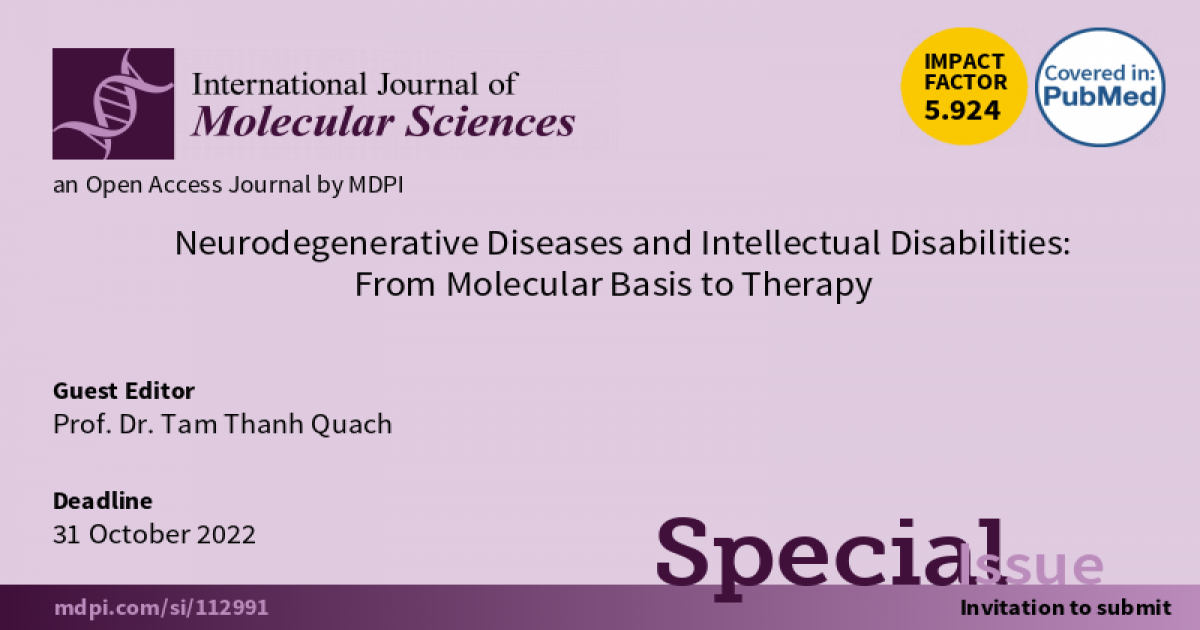- 4.9Impact Factor
- 9.0CiteScore
- 21 daysTime to First Decision
Neurodegenerative Diseases and Intellectual Disabilities: From Molecular Basis to Therapy
This special issue belongs to the section “Molecular Neurobiology“.
Special Issue Information
Dear Colleagues,
Uncovering the specific/common mechanisms underlying the disruption pathways among neurodegenerative diseases (ND) is critical to both basic and applied neuroscience. These findings will contribute to the emergence of the neural system secrets underlying not only our perception, emotion, and cognition under the physiological condition with which we think, act, and react but also highlighting pathological perturbations of neural connectomic networks observed in most well-known major ND displaying impairment in memory and cognition, such as Alzheimer (AD)/Huntington (HD)/amyotrophic lateral sclerosis (ALS)/Creutzfeldt–Jakob diseases (CJD) and Parkinson (PK)/ diseases. Although what causes ND is not fully understand, the accumulation of misfolded/aggregated proteins in the brains is a pathological characteristic of ND. This may initiate the dysregulation/disruption of Ca++signaling, which is a common early pathological event that leads to altered dendritic structures, neuronal dysfunction, and death. Presently, ND gene therapies remain unidimensional, elusive, and limited by the tendency to address one pathological feature while ignoring others. A novel therapeutic approach would include simultaneous targeting genes to break β-sheet formation, change alternative splicing patterns, fine-tune (Ca++)ic, and dendritomorphogenesis by over-expressing multiple effectors (either via AAV-co-transduction or hybrid/dual/triple AAV-vectors administration) and/or by silencing transcripts associated with pathological stress-activated elements (via RNAi or AAV-CRISPR-Cas systems) before vulnerable cells are lost. Such genetic modifiers which are expected to delay or prevent the onset of ND clinical signs may become a tantalizing potential strategy in the future—if such gene transfers were found to treat ND animal models, then the effect of such genes would enhance cognition in control animals.
Dr. Tam Thanh Quach
Guest Editor
Manuscript Submission Information
Manuscripts should be submitted online at www.mdpi.com by registering and logging in to this website. Once you are registered, click here to go to the submission form. Manuscripts can be submitted until the deadline. All submissions that pass pre-check are peer-reviewed. Accepted papers will be published continuously in the journal (as soon as accepted) and will be listed together on the special issue website. Research articles, review articles as well as short communications are invited. For planned papers, a title and short abstract (about 250 words) can be sent to the Editorial Office for assessment.
Submitted manuscripts should not have been published previously, nor be under consideration for publication elsewhere (except conference proceedings papers). All manuscripts are thoroughly refereed through a single-blind peer-review process. A guide for authors and other relevant information for submission of manuscripts is available on the Instructions for Authors page. International Journal of Molecular Sciences is an international peer-reviewed open access semimonthly journal published by MDPI.
Please visit the Instructions for Authors page before submitting a manuscript. There is an Article Processing Charge (APC) for publication in this open access journal. For details about the APC please see here. Submitted papers should be well formatted and use good English. Authors may use MDPI's English editing service prior to publication or during author revisions.
Keywords
- neurodegeneration
- dysproteostasis
- dendritic dystrophy
- gene therapy
- Tau
- ApoE4
- Parkin
- TDP-43
- SOD1
- C9orf 72

Benefits of Publishing in a Special Issue
- Ease of navigation: Grouping papers by topic helps scholars navigate broad scope journals more efficiently.
- Greater discoverability: Special Issues support the reach and impact of scientific research. Articles in Special Issues are more discoverable and cited more frequently.
- Expansion of research network: Special Issues facilitate connections among authors, fostering scientific collaborations.
- External promotion: Articles in Special Issues are often promoted through the journal's social media, increasing their visibility.
- e-Book format: Special Issues with more than 10 articles can be published as dedicated e-books, ensuring wide and rapid dissemination.

